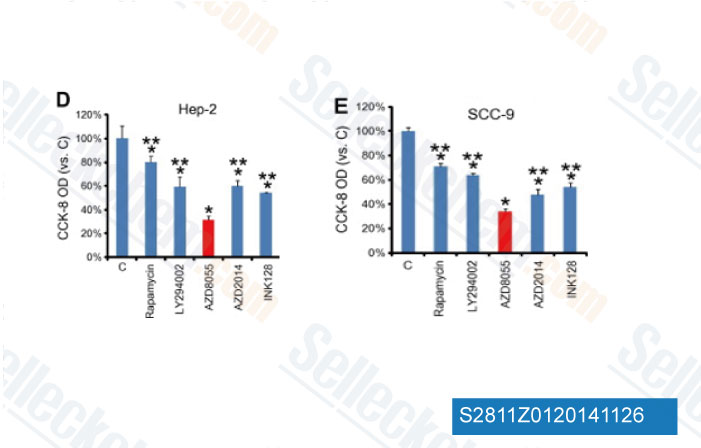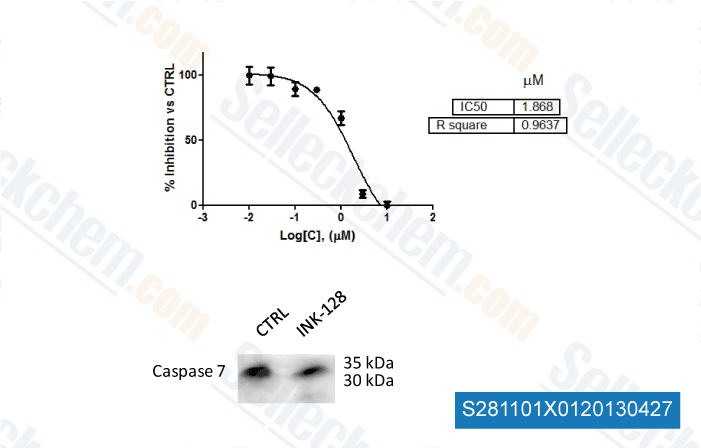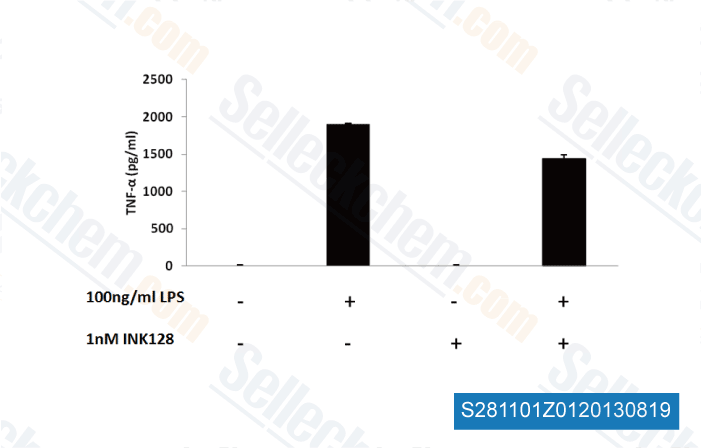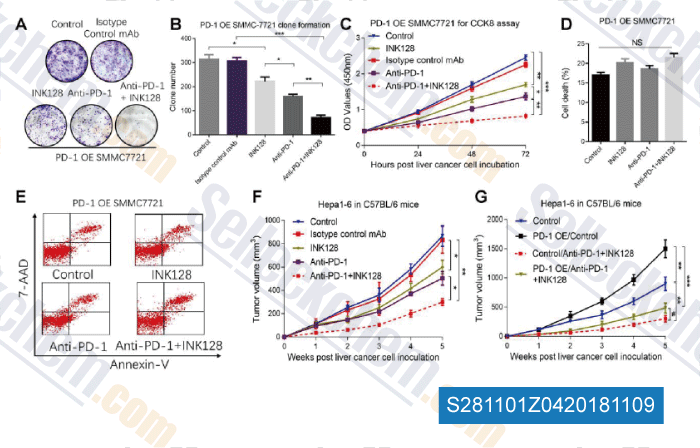|
Toll Free: (877) 796-6397 -- USA and Canada only -- |
Fax: +1-832-582-8590 Orders: +1-832-582-8158 |
Tech Support: +1-832-582-8158 Ext:3 Please provide your Order Number in the email. |
Technical Data
| Formula | C15H15N7O |
||||||
| Molecular Weight | 309.33 | CAS No. | 1224844-38-5 | ||||
| Solubility (25°C)* | In vitro | DMSO | 62 mg/mL (200.43 mM) | ||||
| Water | Insoluble | ||||||
| Ethanol | Insoluble | ||||||
| In vivo (Add solvents to the product individually and in order) |
|
||||||
|
* <1 mg/ml means slightly soluble or insoluble. * Please note that Selleck tests the solubility of all compounds in-house, and the actual solubility may differ slightly from published values. This is normal and is due to slight batch-to-batch variations. * Room temperature shipping (Stability testing shows this product can be shipped without any cooling measures.) |
|||||||
Preparing Stock Solutions
Biological Activity
| Description | Sapanisertib (MLN0128, INK 128, TAK-228) is a potent and selective mTOR inhibitor with IC50 of 1 nM in cell-free assays; >200-fold less potent to class I PI3K isoforms, superior in blocking mTORC1/2 and sensitive to pro-invasion genes (vs Rapamycin). Phase 1. | |||||||||||
|---|---|---|---|---|---|---|---|---|---|---|---|---|
| Targets |
|
|||||||||||
| In vitro | INK 128 exhibits an enzymatic inhibition activity against mTOR and more than 100-fold selectivity to PI3K kinases. [1] As TORC1/2 inhibitor, INK 128 inhibits both the phosphorylation of S6 and 4EBP1, the downstream substrates of TORC1, and selectively inhibits AKT phosphorylation at Ser473, the downstream substrate of TORC2. Furthermore, INK 128 also shows potent inhibition effects on cell lines resistant to rapamycin and pan-PI3K inhibitors. [2] |
|||||||||||
| In vivo | In a ZR-75-1 breast cancer xenograft model, INK 128 shows tumor growth inhibition efficacy at a dose of 0.3 mg/kg/day. [1] Daily, oral administration of INK 128 inhibits angiogenesis and tumor growth in multiplexenograft models. [2] |
Protocol (from reference)
| Animal Study: |
|
|---|
References
|
Customer Product Validation

-
Data from [ Biochem Biophys Res Commun , 2013 , 440(4), 701-6 ]

-
, , Antonino Maria Spart from University of Bologn

-
,

-
Data from [ , , Hepatology, 2017, 66(6):1920-1933 ]
Selleck's Sapanisertib (MLN0128) Has Been Cited by 143 Publications
| Enhancing immunotherapy through PD-L1 upregulation: the promising combination of anti-PD-L1 plus mTOR inhibitors [ Mol Oncol, 2025, 19(1):151-172] | PubMed: 39258533 |
| Uncoupling of Akt and mTOR signaling drives resistance to Akt inhibition in PTEN loss prostate cancers [ Sci Adv, 2025, 11(6):eadq3802] | PubMed: 39919177 |
| A TFEB-TGFβ axis systemically regulates diapause, stem cell resilience and protects against a senescence-like state [ Nat Aging, 2025, 5(7):1340-1357] | PubMed: 40588651 |
| PI3K/mTOR inhibition induces tumour microenvironment remodelling and sensitises pS6high uterine leiomyosarcoma to PD-1 blockade [ Clin Transl Med, 2024, 14(5):e1655] | PubMed: 38711203 |
| PI3K/mTOR inhibition induces tumour microenvironment remodelling and sensitises pS6high uterine leiomyosarcoma to PD-1 blockade [ Clin Transl Med, 2024, 14(5):e1655] | PubMed: 38711203 |
| Starvation-induced phosphorylation activates gasdermin A to initiate pyroptosis [ Cell Rep, 2024, 43(9):114728] | PubMed: 39264808 |
| NFκB and JNK pathways mediate metabolic adaptation upon ESCRT-I deficiency [ Cell Mol Life Sci, 2024, 81(1):458] | PubMed: 39560723 |
| Different Impacts of DNA-PK and mTOR Kinase Inhibitors in Combination with Ionizing Radiation on HNSCC and Normal Tissue Cells [ Cells, 2024, 13(4)304] | PubMed: 38391917 |
| PI3K-dependent reprogramming of hexokinase isoforms controls glucose metabolism and functional responses of B lymphocytes [ iScience, 2024, 27(10):110939] | PubMed: 39635128 |
| Epstein-Barr Virus Latent Membrane Protein 2A (LMP2A) Enhances ATP Production in B Cell Tumors through mTOR and HIF-1α [ Int J Mol Sci, 2024, 25(7)3944] | PubMed: 38612754 |
RETURN POLICY
Selleck Chemical’s Unconditional Return Policy ensures a smooth online shopping experience for our customers. If you are in any way unsatisfied with your purchase, you may return any item(s) within 7 days of receiving it. In the event of product quality issues, either protocol related or product related problems, you may return any item(s) within 365 days from the original purchase date. Please follow the instructions below when returning products.
SHIPPING AND STORAGE
Selleck products are transported at room temperature. If you receive the product at room temperature, please rest assured, the Selleck Quality Inspection Department has conducted experiments to verify that the normal temperature placement of one month will not affect the biological activity of powder products. After collecting, please store the product according to the requirements described in the datasheet. Most Selleck products are stable under the recommended conditions.
NOT FOR HUMAN, VETERINARY DIAGNOSTIC OR THERAPEUTIC USE.
